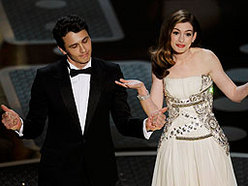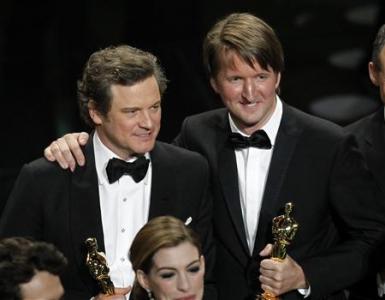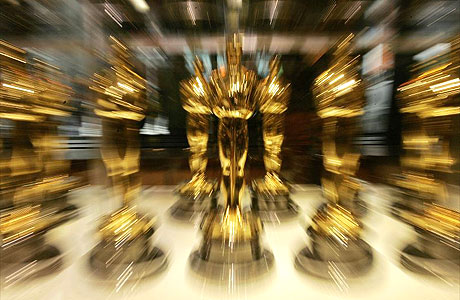UPDATE March 7: The Hurt Locker has just won 6 Oscars including Best Picture and Best Director. CLICK HERE to read Oscar Results 2010.
UPDATE Feb. 21: The Hurt Locker just won Best Picture at the BAFTA Awards (British Academy of Film and Television Arts). Kathryn Bigelow became the first woman to win Best Director. “I would like to dedicate this to never abandoning the need to find a resolution for peace,” she said in her acceptance speech. Mark Boal won Best Original Screenplay. CLICK HERE TO READ MORE.
CLICK HERE TO VIEW THE ACCEPTANCE SPEECHES.

With The Hurt Locker, Kathryn Bigelow could well have shattered the stereotype of female filmmakers, if there even was an image established for them. But a good guess is that they have generally been misconstrued as merely producers of romances, tear jerkers, simply put, ‘chick flicks’. A look at Bigelow’s filmography shows a track record of action thrillers. But it’s with The Hurt Locker, a captivating work about a bomb disposal team in Iraq, that she has garnered floods of accolade.
Professor Martha Lauzen of San Diego State University studies women in the movie industry over the years. She found that women represented only 9 per cent of Hollywood directors in 2008 – the same figure she had recorded in 1998. In this male-dominated circle, Bigelow is only the fourth woman ever in the 82-year history of the Oscars to be nominated Best Director. The other three were Lina Wertmuller (Pasqualino Settebellezze, 1975), Jane Campion (The Piano, 1993) and Sofia Coppola (Lost In Translation, 2003). None of them won.
Recently, Bigelow made history by being the first woman to win the Director’s Guild Award with The Hurt Locker. According to past trend, winners of the DGA usually went on to win the Oscar, with a few exceptions. Bigelow could be making Oscar history as well comes March 7. But of course, she has tough competition from her ex James Cameron.
The Hurt Locker focuses on an Explosive Ordnance Disposal (EOD) team in Iraq in 2004. In this urban guerrilla war zone, the signature weapon is the Improvised Explosive Device (IED), or, roadside bomb. What stands out in this film is the intense psychological tension captured by the camera, the excellent editing, and the poignant performance of the three specialists in the EOD team. The nuanced playing out of their opposing psyche and the dynamics of their interactions are what fuel the riveting momentum.
Into this three-men EOD team the story zooms in on one character, Sgt. Will James (Jeremy Renner), bomb specialist, reckless maverick whose hubris and adrenalin cravings propel his dubiously heroic acts. The quote at the beginning gives a hint of what is to come: “… war is a drug.” Unlike other typical reactions to war, James embraces it. The whole movie is a character study exploring such a psychological make-up. And we are held on the edge of our seats as we follow the Dirty Harry of Baghdad clearing IED’s on the streets.
But the script excels in presenting a multi-layered character. As the story progresses, we see a softer side to the tough bomb expert, and yet, all revealing is movingly restrained. Renner’s performance is magically convincing. He has me on his side as soon as he appears on screen.
Using relatively unknown actors, the film poignantly portrays the vulnerability of Everyman in the war zone. But they can’t be unknown anymore after this. Jeremy Renner (Sgt. Will James), Anthony Mackie (Sgt. Sanborn), and Brian Geraghty (Spc. Owen Eldridge) have left their impressive marks here. Pitching in, albeit for only short moments, are some more well-known actors, Ralph Fiennes, Guy Pearce and David Morse.
Impressively shot like a documentary, its every scene intense, drawing the viewer in like a participant, an onlooker. Great camera works, excellent editing, breath-taking pacing, and thoroughly human.

Unlike other war movies, there are few bloody scenes, no gratuitous war mongering or protesting. Bigelow in the special feature mentions that the film takes an apolitical, non-partisan stance. Such a neutral, matter-of-fact depiction, focusing on the micro-level of three men handling the most dangerous job in the world, is no less powerful in conveying the danger, the sacrifice, and the courage needed to go through every single day in Iraq. The film stands out among other war movies in its sensitive and sometimes even eloquent treatment of the raw emotions and the dynamics of personalities caught in a hurt locker.
The term ‘hurt locker’ refers to a situation of extreme pain and hardship. The production itself could well illustrate the point. Filmed on location in Jordan, cast and crew had to endure long hours in searing heat of 115 degrees, had to make do with scarce resources, and improvise in tough circumstances. It had been suggested that “no woman over 40 could possibly have the stamina to direct a feature film.” Overcoming such a sexist view is the challenge every woman director has to face. Bigelow has proven herself to be admirably competent, crafting and delivering a superb production with an all male cast, (except a short appearance by Evangeline Lilly), in a land far from home.
The Hurt Locker ties with Avatar with 9 Oscar noms, including Best Picture and Best Director, but it gets nods in two categories that Avatar doesn’t, Best Actor and Best Writing, Screenplay written directly for the screen.
Jeremy Renner receives a Best Actor nod for his engrossing performance as Staff Sgt. William James. A fusion of James McAvoy and Russell Crowe, Renner has proven himself to be a worthy contender in the Oscar race.
Mark Boal gets an Oscar nom for his very first screenplay. This in itself is impressive, and a pointer to what makes a good piece of writing: write what you know. His personal 2004 experience in Baghdad as an embedded journalist with a bomb squad is what makes the story, characters, and every single detail so real and poignant.
The DVD has some fascinating Special Features capturing the Behind The Scene moments, a Gallery, and commentaries from Bigelow and Boal. Those who want to see the film before the Awards show will have to opt for the DVD. As a smaller, indie production, The Hurt Locker had only a short release in selective theatres. Hopefully after March 7, it might get a chance to be put on the big screen again. So, now you know who I root for comes Oscar night.
~ ~ ~ ½ Ripples
***
***






 When the idea of building the World Trade Center Twin Towers began to germinate in NYC, on the other side of the globe, a young man in France started to weave a dream. He wanted to walk across the top of the Towers on a wire after they were built. Six years later, with the Towers nearing completion, Philippe Petit fulfilled his dream a few days short of his 25th birthday. On August 7, 1974, he stepped on a wire strung across the roof top of the then tallest buildings in the world. Hailed as ‘The Artistic Crime of the Century’, Philippe Petit’s breathtaking, and illegal, high wire act is the ultimate test of the human spirit, pushing the limit of audacity and strength.
When the idea of building the World Trade Center Twin Towers began to germinate in NYC, on the other side of the globe, a young man in France started to weave a dream. He wanted to walk across the top of the Towers on a wire after they were built. Six years later, with the Towers nearing completion, Philippe Petit fulfilled his dream a few days short of his 25th birthday. On August 7, 1974, he stepped on a wire strung across the roof top of the then tallest buildings in the world. Hailed as ‘The Artistic Crime of the Century’, Philippe Petit’s breathtaking, and illegal, high wire act is the ultimate test of the human spirit, pushing the limit of audacity and strength.
